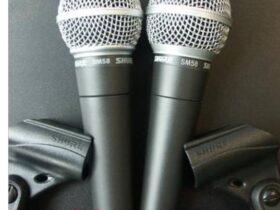Contents
Today’s microphones have what is known as a polar pattern, but what exactly is it? What is a microphone polar pattern? Why is it important? Despite sounding complicated, a polar pattern describes the inherent directionality of a microphone. A microphone’s polar pattern refers to its sensitivity to sounds arriving from different angles towards its center.
Perfect Pitch
Let’s look at an example in pictorial form. An image of a microphone’s polar pattern is a top-down view facing forward of a microphone. Based on the image, the front of the microphone is marked by zero degrees, the back is 180 degrees, and the left and right edges are 270 degrees and 90 degrees, respectively. Each circle’s circumference represents a 5-decibel (dB) reduction in audio sensitivity from outside to inside.
It can be seen that the polar pattern touches the outermost circle at zero degrees and falls below -5 dB at 90 and 270 decibels. In other words, the microphone is less sensitive at its sides than at its front by more than 5 dB.
As we move towards the rear of the microphone, we can see that the sensitivity continues to decline increment until it reaches zero dB at the very back. From a theoretical standpoint, this implies that no sound should be captured from the rear of
Using a polar pattern to make the most acceptable choice
What is a microphone polar pattern? Why is it important? Once you understand polar pattern images, you can visualize any recording microphone’s directionality quickly and easily. By utilizing this information, you will be in a position to select the most appropriate microphone for your next audio session. Furthermore, you will be able to identify the most sensitive and least sensitive parts of a microphone’s polar pattern. As a result, you will be able to make informed decisions about microphone placement, to maximize the capture of a sound source’s desired output and minimize the capture of unwanted sounds.
Even though a microphone might sound fantastic in theory, if the polar pattern does not complement your desired sound source or recording environment, it may not be the right choice for you. What is a microphone polar pattern? Why is it important?
One of the most common uses of polar patterns for isolation is micing up to a drum kit. How do we define this? You can read more about this activity in an upcoming post.
Directional polar patterns
As shown in the example above, the cardioid polar pattern is the most common of the directional polar patterns. Due to the shape of the response (hence cardio), it is widely used when one sound source must be concentrated, and side and rear pickup reduced simultaneously.
On stage, a vocalist could use a handheld microphone to perform live. In addition to effectively capturing the singer’s voice, the microphone captures a cardioid polar pattern. However, it also blocks out other sounds from the foldback monitors and other performers.
The X/Y stereo technique can be created by pairing cardioid microphones held at a 90-degree angle to one another. The NT4 microphone and Stereo VideoMic feature this method to separate left and proper captures of the sound source. In a future article, this technique will be discussed in greater detail.
Hyper-cardioid and super-cardioid polar patterns
These polar patterns are variations of the classic cardioid shape but with a tighter frontal direction. They also pick up sound from the rear and sides if they are close to the capsule. In the case of either of these cardioid polar patterns, this characteristic must be taken into account.
Shotgun microphones are the most extreme examples of directional devices. With a narrow front pickup area – sounds coming from all other sides will be largely ignored. In shotgun microphones, the longer the line tube, the tighter the polar pattern. They are most commonly used on film and television sets where sound needs to be picked up from a distance. The shotgun microphone is also used in wildlife documentaries and sports events.
Bidirectional (figure-of-eight) polar pattern
Figure-of-eight microphones pick up equal sound levels from front and back, but not from the sides, hence their ‘8’-shaped polar pattern. By capturing more of the natural ambiance of the recording space and the sound source, highly realistic sound reproduction can be achieved. Like all devices of this type, this device features a figure-of-eight polar pattern.
They are also used in the famous ‘Blumlein’ and ‘mid/side stereo recording techniques. In an upcoming article, we will discuss figure-of-eight microphones in greater detail, along with recording techniques and stereo arrays.
Omnidirectional polar pattern
Omnidirectional microphones capture sound from all directions in a smooth sphere, producing a natural and realistic recording. In general, omnidirectional microphones include lavalier and headset varieties, allowing the talent to move their head naturally without altering the overall recording. What is a microphone polar pattern? Why is it important?
When choosing your RØDE microphone, be sure to look at the polar pattern graphics found in the specs section for each device. You will be able to choose the right microphone based on these factors.
Keep an eye on the RØDE blog for more exciting upcoming articles – shortly, you can learn about microphone placement, selection, and recording techniques.
WHAT ARE THE BENEFITS?
- Suitable for most recording applications
- The highest rejection at the rear reduces bleed from sources behind your microphone.
- Removes unwanted ambient noise from the microphone
- A focused sound puts your sound source front and center.
- Reduces bleed and feedback on stage
- Stereo X/Y recordings can be created by pairing them.
Conclusion
what is a microphone polar pattern? why is it important? The crash course in microphone transducers, polar patterns, and frequency response is complete. A high-quality result requires mastering the basics at this stage of the signal chain. Inputs are more critical than outputs if you only take one thing away from this article. If you fail to get things right at the beginning of the signal chain, you will only have headaches later. Armed with the fundamentals, you can now make an informed choice to ensure your signal – whether for live or studio use – is set up correctly.
Related Posts:
The Best Electric Violin For Professionals
The Best Amp For Klipsch RP-600M






